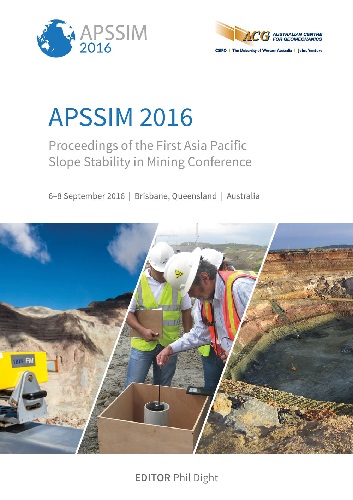Large scale three-dimensional pit slope stability analysis of the structurally controlled mechanism in Mae Moh coal mine

|
Authors: Chaiwan, A; Leelasukseree, C; Mavong, N |
DOI https://doi.org/10.36487/ACG_rep/1604_40_Chaiwan
Cite As:
Chaiwan, A, Leelasukseree, C & Mavong, N 2016, 'Large scale three-dimensional pit slope stability analysis of the structurally controlled mechanism in Mae Moh coal mine', in PM Dight (ed.), APSSIM 2016: Proceedings of the First Asia Pacific Slope Stability in Mining Conference, Australian Centre for Geomechanics, Perth, pp. 601-610, https://doi.org/10.36487/ACG_rep/1604_40_Chaiwan
Abstract:
Mae Moh Mine is the largest open pit coal mine in the Southeast Asia, which coal production, is used wholly for 14 percent of Thailand electricity generation. The great challenge in the very near future is the stability of the massive great wall, called ‘C1-Westwall’ area. The batter is susceptible to the risk of the large scale blocks sliding determined by the geological structures and discontinuities, such as faults, joints, weak layers and bedding plane shears, abundantly existing in the under burden rock mass. The potential sliding rock mass of more than 200 metres high batter could be susceptible to the catastrophic event and affects to the continuity of the project. The wall conceptual adjustment was initially proposed in 2013, concerning with approximately 43 million cubic metres of under burden rock mass which would be excavated according to the old mine master plan. The review of geological structures has shown that there is the possibility to re design the shape of this wall portion which could be led to the substantially waste removal cost saving. Due to the nature of the area of interest, complex geological setting make the problem should be considered in the three-dimensional. The evaluation of wall stability for safe and feasible mining, the 3DEC® (Itasca Consulting 2007) was selected as the tool of the trade by the advantage of discontinuum modelling approach, which facilitates the explicit joints modelling. Block joints cutting models with statistical orientations of bedding planes were analysed to get the results and better understanding of the rock blocks movement tendency in relation to the orientations of controlling structures. Another benefit which has been gained from this ‘experiment’ is the awareness to the potential hazard that proved to be existed and still be needed to be thoroughly evaluated. This is the first step to the efficient slope re-design procedure of the Mae Moh Mine pit wall, for the long-term mine planning.
Keywords: large scale open pit slope, slope stability analysis, structurally controlled failure mechanism, discontinuum modelling
References:
Brawner, CO 1990, Geotechnical Review – Mae Moh Mine, Thailand.
Dight, PM 1994, Report on Geotechnical Site Visit Mae Moh Mine, Thailand.
Hoek, E & Bray, J 1981, Rock Slope Engineering, 3rd edition, The Institution of Mining and Metallurgy, London.
Itasca Consulting 2007, 3DEC 3 Dimensional Distinct Element Code, Itasca Consulting Group, Inc., www.itascacg.com
Leelasukseree, C & Mavong, N 2012, ‘Initial slope stability study of undercut slope at Area 4.1 Mae Moh Mine, Lampang, Thailand’, in C Hawkes (ed.), Proceedings of the 21st Canadian Rock Mechanics Symposium, Canadian Rock Mechanics Association and Canadian Institute of Mining, Metallurgy and Petroleum, Edmonton, pp. 209–217.
McMahon, B 1990, Report on Geotechnical Site Visit Mae Moh Mine, Thailand.
Mine Engineering Department 2015, Mae Moh Mine Stage Plan, Electricity Generating Authority of Thailand, Thailand.
Pipatpongsa, T, Heng, S, Likitlersuang, S, Mungpayabal, N & Ohta, H 2011, ‘Investigation of mechanical properties of clay seam in bedding shears of the Mae Moh open-pit mine of Thailand’, in MA Shahin & HR Nikraz (eds), Proceeding of the International Conference on Advances in Geotechnical Engineering, Department of Civil Engineering, Curtin University, Perth, pp. 209–220.
Sullivan, TD 1990, Report on Geotechnical Review, Mae Moh, Thailand.
Thailand-Australia Lignite Mines Development Project 1985, Mae Moh Geotechnical Report Volume 1 to 5, Electricity Generating Authority of Thailand, Thailand.
© Copyright 2025, Australian Centre for Geomechanics (ACG), The University of Western Australia. All rights reserved.
View copyright/legal information
Please direct any queries or error reports to repository-acg@uwa.edu.au
View copyright/legal information
Please direct any queries or error reports to repository-acg@uwa.edu.au